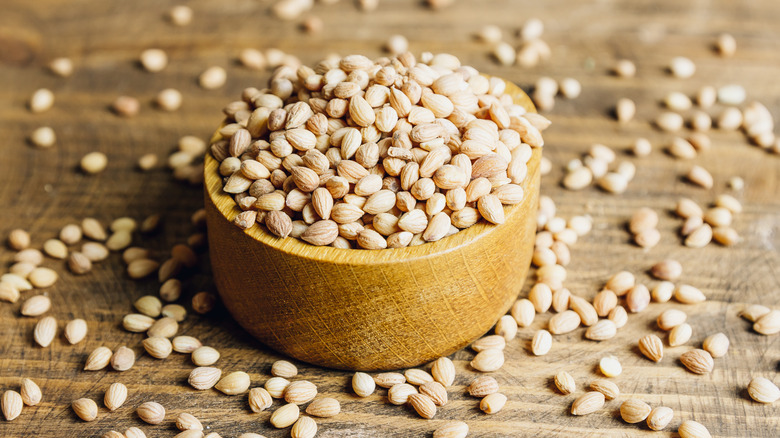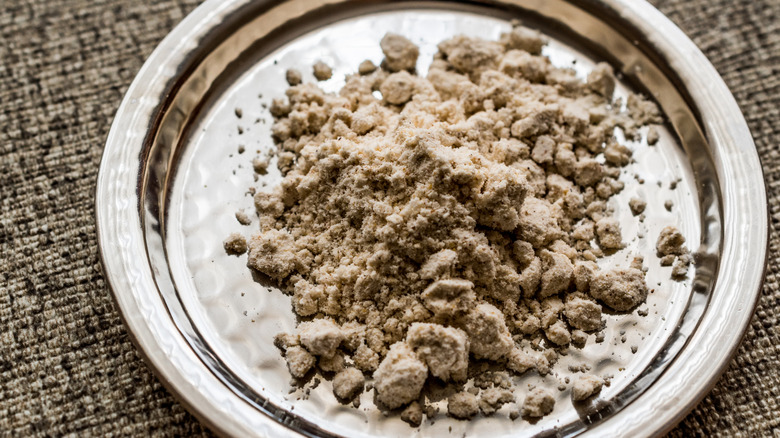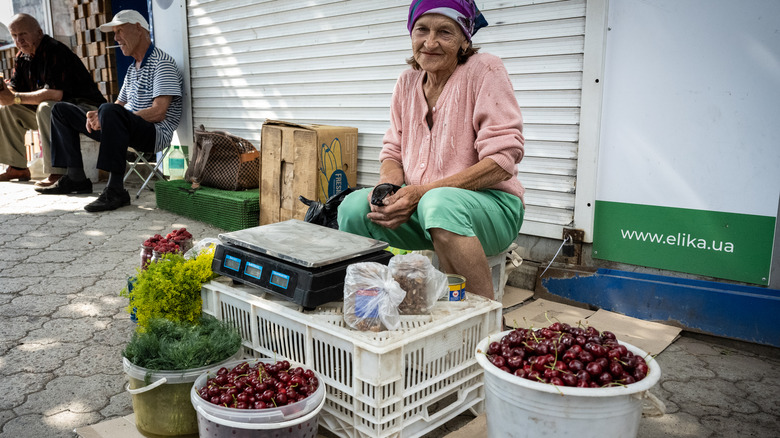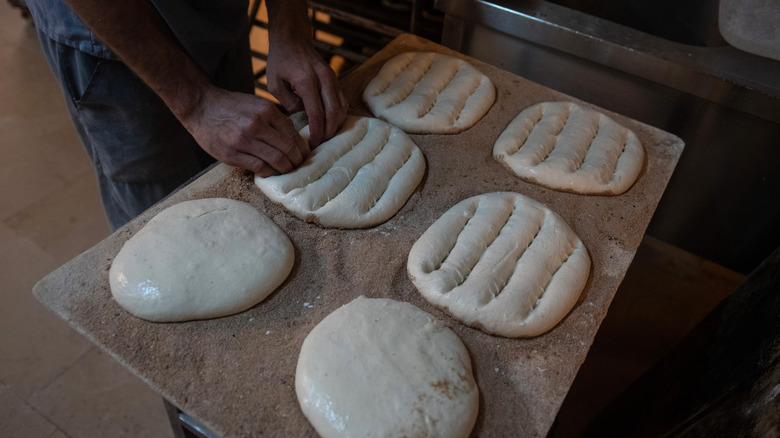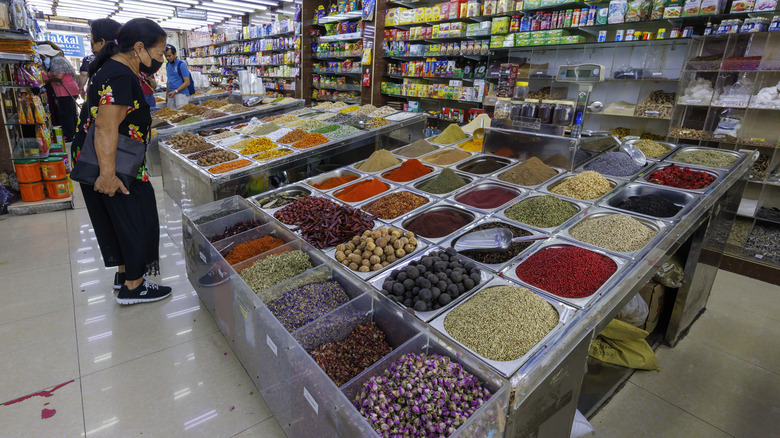What Is Mahlab And Why You Should Add It To Your Spice Collection
The star of kitchens all over the Middle East and along the Mediterranean, Mahlab is a signature spice that adds an intense and rich depth of flavors to baked goods for all occasions. Ever wonder why some of your favorite desserts are so delicious — like Armenian cookies or sweet Greek brioche — but you can't quite pick up where the notes and unique taste of sweet, tart, and nutty-ness come from? The answer may be mahlab. According to Serious Eats, mahlab is a spice that can thoroughly merry the tasting characteristics of almonds, cherries, and hints of roses all in one.
Whether baking a bundt cake, a cookie, or even a traditional scone, mahlab may be the secret ingredient to level up your baked goods. The perfect balance of sweet and nutty, learn where mahlab comes from and how best to incorporate it into your recipes as we dive into every you must know about this one-of-a-kind spice.
What is Mahlab?
The origin of the beloved mahlab is quite sweet — physically speaking. You may be surprised to hear how this rich spice, with notes of vanilla and almond, actually comes from a fruit, according to La Boite. Mahlab kernels come from the seeds of the Prunus mahaleb, otherwise known as St. Lucie, a type of wild cherry. To extract mahlab kernels, each cherry pit (or stone) is forced open to reveal a soft kernel inside measuring roughly 5mm in diameter. When the mahlab kernel is extracted from the cherry whole, it's important to note that the kernels are not what bread makers and pastry chefs use for their baked goods. Mahlab kernels are grounded either mechanically or through a mortar and pestle and then incorporated as a powder.
Famously used in Middle Eastern and European baked goods, it's only fitting that the origin of mahlab's St. Lucie cherry trees are found in both the Mediterranean and Central Asia, according to Curio Spice. This delicacy is not only a 'must-have' ingredient for the region's local offerings but also convenient.
The Origin of Mahlab
So, how did the first culinary extraordinaire decide to enhance their dishes with a sour, undesired cherry? Or, who was the first to engrain the practice of splitting a cherry pit, drying it, and grinding the inside kernel to reveal a wonderful-tasting spice with an extensive flavor profile? According to Tablet Mag, mahlab's exact origin remains a mystery. Master spice blender Lior Lev Sercarz wrote in The Spice Companion, "I am not sure where the idea came about to use the kernel of this distasteful sour cherry, but I'm glad someone thought of it."
However, when it comes to where the spice may have originated, mahlabs' footprint can be found across Greece, Syria, Iran, and Turkey, alongside regions in the Middle East and Southern Europe. This gives us a good inclination that it was a widely accepted and adopted culinary practice to extract mahlab where the native St. Lucie cherry trees grew.
Is mahlab good for you?
If incorporating a sweet and nutty spice into your baked goods didn't sound enticing, maybe the thought of extensive health and nutritional benefits will convince you to invest in trying mahlab. According to Spicography, mahlab's benefits on the body are outstanding and are believed to help with illnesses like Alzheimer's, asthma, osteoporosis, and even the growth of tumors.
The long list of health benefits has to do with a few of mahlab's included compounds like coumarins, oleic acid, and linoleic acid. These contribute to the spice consisting of rich omega-three fatty acids and the phenomenal taste (coumarins). Additionally, because of the linoleic acid, per Foods Trend, mahlab's composition of stotoxic substances is believed to give the spice a "natural chemotherapy effect" when put up against cancer cells like leukemia.
As the natural flavor profile of mahlab is sweet, it's also an excellent sugar substitute and can be used as an anti-diabetic sweetener due to the low starch count.
How to bake with mahlab
Now that you've heard about all the wonderful flavors, health benefits, and recipe inspiration – how does one bake with mahlab? It's simple, really; you incorporate the spice into your next baked good recipe. According to Serious Eats, mahlab should be treated similarly to nutmeg in its potency. It can bring a lot to a baked good, whether a loaf of bread or a muffin, but it can be overpowering if too much is used. The rule of thumb when baking with mahlab is that a little goes a long way.
Unlike nutmeg, mahlab powder should not be stored for long periods of time in powdered form. Unfortunately, mahlab can lose its flavor very quickly and should be freshly grounded before use. To avoid copious amounts of baked goods in one baking session, store the mahlab kernels and ground small batches at a time when intending to use them for your next recipe.
Fun fact: mahlab is also great added to cheese.
Where to buy mahlab?
While you may have to dig a little, we promise that mahlab is not difficult to find. Traditionally mahlab can be easily spotted in Greek markets around Easter time — thanks to its iconic feature in the holiday's bread, Tsoureki. However, your location and time of year to purchase are not limited to this small window. Bakers all over the world can find mahlab in their local specialty food stores, spice shops, and even online for delivery. One important note when purchasing your mahlab order is to keep in mind the powder versus whole kernels. While it may look more convenient to buy powder — opt for the freshness and rich taste of grinding your kernels for your recipe.
We hope mahlab makes its way to your kitchen's spice rack and acts as your new favorite kitchen accessory to dress your favorite baked goods with — whether they be sweet or savory.
